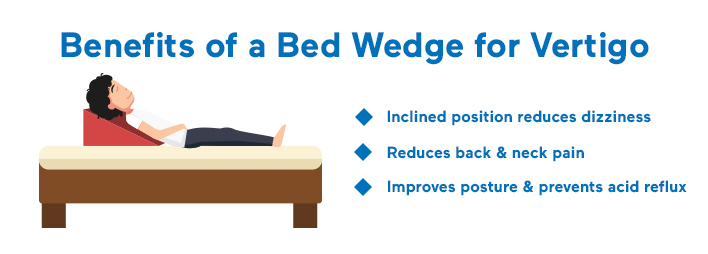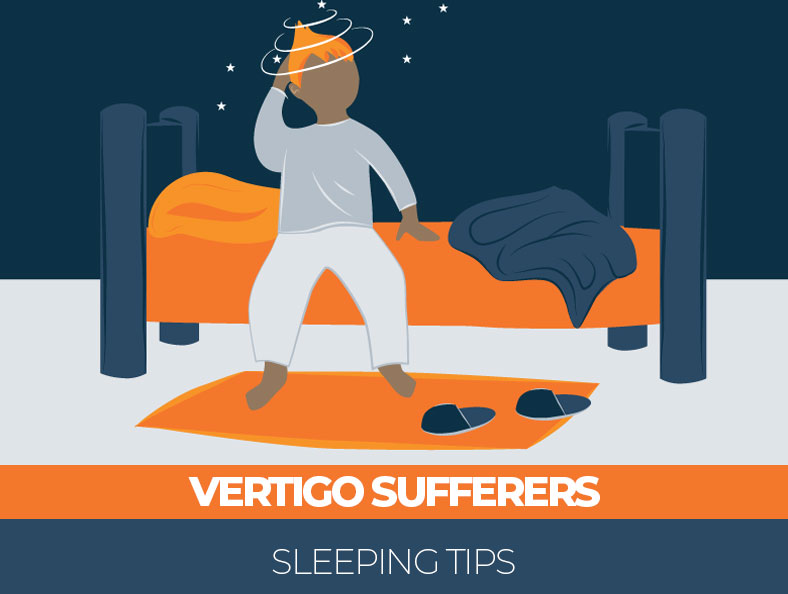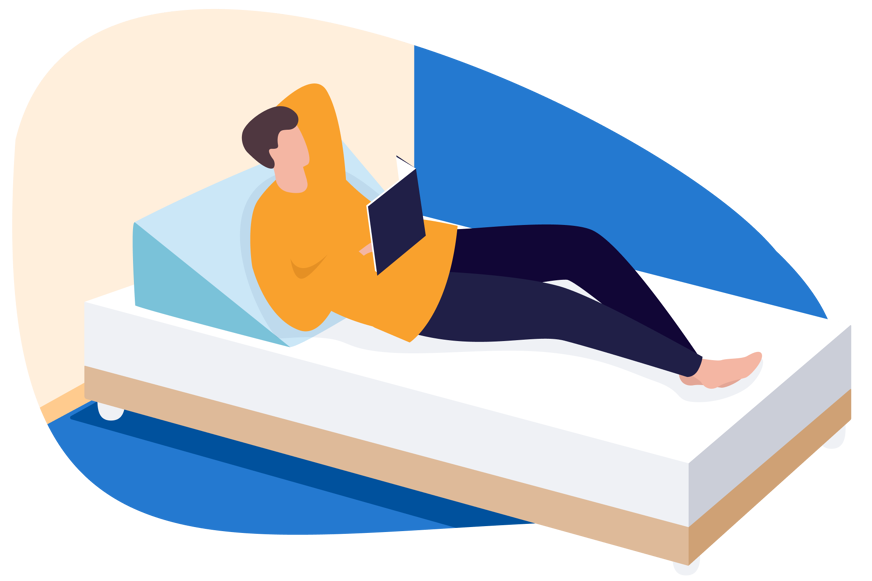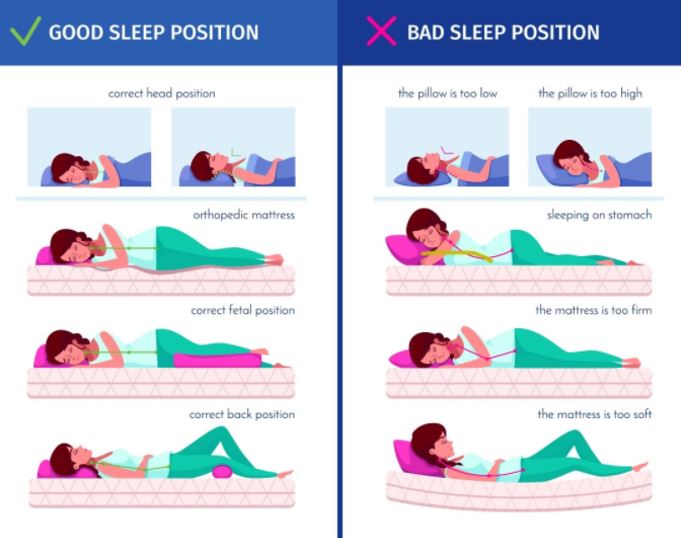Best Way To Sleep With Vertigo

The bedroom spins, not in a pleasant, post-celebration kind of way, but with a relentless, disorienting force. You grip the mattress, your stomach lurching with each imaginary rotation. Sleep, that sweet, restorative escape, feels miles away, replaced by the unwelcome visitor of vertigo, turning your sanctuary into a torture chamber.
Navigating life with vertigo is a challenge, and finding a comfortable sleeping position can feel like an impossible task. But there’s hope. With strategic adjustments to your sleep environment and routine, you can minimize the dizzying effects and reclaim your nights.
Understanding Vertigo and Its Impact on Sleep
Vertigo isn't just feeling a little dizzy; it's a false sensation that you or your surroundings are moving or spinning. This sensation arises from a disturbance in the inner ear or the brain, the systems responsible for balance and spatial orientation. According to the National Institute on Deafness and Other Communication Disorders (NIDCD), several factors can trigger vertigo, including benign paroxysmal positional vertigo (BPPV), Meniere's disease, and vestibular neuritis.
For many, the spinning sensation intensifies when lying down or changing positions in bed. This is because these movements can shift the fluid and crystals in the inner ear, further disrupting the balance signals sent to the brain. The disruption then leads to heightened symptoms and making sleep elusive.
Common Vertigo Triggers:
Understanding the triggers can help you proactively manage your symptoms. BPPV, one of the most common causes, is often triggered by specific head movements. Infections, head injuries, migraines, and certain medications can also contribute to the onset of vertigo. Identifying and addressing these underlying causes is crucial for long-term management.
"Vertigo can significantly impact quality of life, leading to anxiety and depression due to the constant fear of experiencing another episode," explains Dr. Emily Carter, a leading neurologist specializing in vestibular disorders.
Optimizing Your Sleep Environment
Creating a comfortable and supportive sleep environment is the first step toward a vertigo-free night. The goal is to minimize movement and provide stability.
Start with your pillows. Elevating your head with multiple pillows can reduce the likelihood of fluid shifting in the inner ear. The ideal elevation is typically around 30 to 45 degrees. Experiment with different pillow arrangements to find what feels most comfortable and supportive for your neck and head.
Next, consider your mattress. A firmer mattress provides more support and reduces motion transfer if you share a bed. This means that if your partner moves, you're less likely to be disturbed and experience a vertigo flare-up.
Bedroom Setup for Vertigo Sufferers:
Keep your bedroom dark, quiet, and cool. These conditions promote relaxation and reduce sensory input that could exacerbate vertigo symptoms. Blackout curtains, a white noise machine, and a comfortable room temperature can make a significant difference.
Ensure your bedroom is free of clutter. A clear path to the bathroom is essential for nighttime trips, minimizing the risk of falls if you experience a sudden bout of dizziness. Consider installing nightlights to provide gentle illumination without being overly stimulating.
Finding the Right Sleeping Position
The best sleeping position for vertigo varies from person to person, but there are some general guidelines to follow. Sleeping on your back with your head elevated is often recommended. This position keeps your head stable and reduces the chance of fluid shifts in the inner ear.
If you prefer sleeping on your side, try sleeping on the side that doesn't trigger your vertigo. If tilting your head to the right causes dizziness, sleep on your left side. Using a body pillow can also provide extra support and prevent you from rolling onto your stomach, which can worsen symptoms.
Avoid sudden movements when getting into or out of bed. Sit on the edge of the bed for a few moments before standing up. This allows your body to adjust gradually and reduces the likelihood of triggering a vertigo episode.
Specific Positions to Avoid:
Sleeping on your stomach is generally not recommended, as it requires you to turn your head to the side, which can exacerbate vertigo. Avoid positions that involve rapid head movements or extreme neck flexion.
Establishing a Bedtime Routine
A consistent bedtime routine signals to your body that it's time to sleep, helping to regulate your sleep-wake cycle and reduce anxiety associated with vertigo. Start by winding down at least an hour before bed.
Avoid screen time (phones, tablets, and computers) close to bedtime. The blue light emitted from these devices can interfere with melatonin production, a hormone that regulates sleep. Instead, opt for relaxing activities like reading a book, listening to calming music, or taking a warm bath.
Practice relaxation techniques such as deep breathing or meditation. These techniques can help reduce stress and anxiety, which can often worsen vertigo symptoms. Many free apps and online resources offer guided meditations specifically designed for relaxation and sleep.
Dietary Considerations:
Avoid caffeine and alcohol before bed. These substances can disrupt sleep and potentially trigger vertigo episodes. Eating a light, healthy snack before bed can help stabilize blood sugar levels and prevent nighttime awakenings.
Medical Interventions and Therapies
If lifestyle adjustments aren't enough, there are several medical interventions and therapies that can help manage vertigo. The Epley maneuver, a series of head movements performed by a healthcare professional, is highly effective for treating BPPV.
Vestibular rehabilitation therapy (VRT) is another option. VRT involves exercises that help retrain the brain to compensate for inner ear problems. Medications such as antihistamines and antiemetics can also provide temporary relief from vertigo symptoms.
In rare cases, surgery may be necessary to correct underlying structural problems in the inner ear. Always consult with a healthcare professional to determine the best course of treatment for your specific condition. According to the Vestibular Disorders Association (VEDA), early diagnosis and treatment can significantly improve outcomes for people with vertigo.
Living Well with Vertigo: A Holistic Approach
Managing vertigo is an ongoing process that requires a holistic approach. In addition to optimizing your sleep environment, finding the right sleeping position, and establishing a bedtime routine, consider other lifestyle factors that can influence your symptoms.
Regular exercise can improve overall health and reduce stress, which can help manage vertigo. However, avoid activities that trigger your symptoms. Tai chi and yoga, known for their gentle movements and focus on balance, can be particularly beneficial.
Stress management is crucial. Chronic stress can worsen vertigo symptoms. Practice relaxation techniques regularly and find healthy ways to cope with stress, such as spending time in nature, pursuing hobbies, or connecting with loved ones.
Living with vertigo can be challenging, but it doesn't have to control your life. With careful planning, a supportive environment, and appropriate medical care, you can reclaim your nights and experience restful, rejuvenating sleep. Remember that you are not alone, and there are resources available to help you navigate this journey.
As the world outside quiets, and you settle into your prepared haven, remember the power of small changes. Each adjusted pillow, each deliberate breath, is a step toward a calmer, steadier night. It's a journey of self-care and adaptation, proving that even amidst the spin, tranquility is within reach.


















